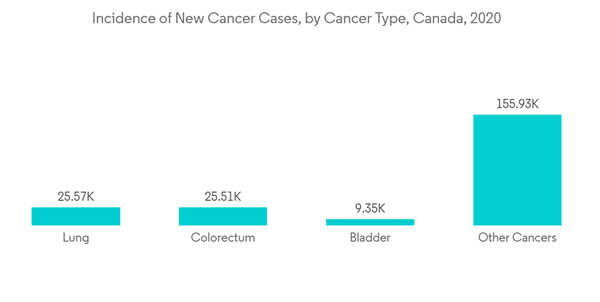The COVID-19 epidemic impacted the market expansion. In July 2021, it was predicted that the delay in surgical treatments for patients with breast cancer caused by COVID-19 will result in 700 additional fatalities in Canada, according to an article in Imaging Technology news. Breast cancer screenings and treatments are gradually recovering to pre-pandemic levels as immunizations are given across the nation. Only 12 new CT scan machines were brought to the nation in 2020, which is the lowest number in the previous 20 years, according to a report provided by the Canadian Association of Radiologists in July 2021. Additionally, CT scans took Canadians 50 to 82 days on average to receive. This exceeds the advised 30-day wait time by 20 to 52 days. Waitlists are significantly longer as a result of COVID-19, placing Canada in a medical imaging crisis. However, COVID-19 has given major market participants the chance to establish their positions with the benefits of computed tomography devices. For instance, Spectrum Dynamics Medical Inc.'s premium digital SPECT/64-slice CT scanner, Veriton-CT64, which is intended for both hybrid imaging for both full body and organ focused, with reduced scan times, acquired a Canadian Medical Device License from Health Canada. With the help of this technology, routine hybrid 3D imaging for scans of the heart, brain, and lungs may be completed in less than 20 minutes. Thus, the market is expected to grow in the future.
The high prevalence rate of chronic diseases, such as cancer, diabetes, cardiovascular diseases, and neurological disorders, is a primary factor driving the Canadian computed tomography market. The country's market is additionally influenced by the nation's ageing population growth, technological developments in the relevant industry, expanding R&D practises, rising investments, and a rise in product releases. The most prevalent chronic illnesses in Canada, according to a report released in August 2020 by Benefits by Design, are arthritis, cancer, diabetes, heart conditions, mental illness, and stroke. In 2020, cancer will account for 30% of all fatalities in Canada, making it the country's leading killer. Heart failure affects 600,000 Canadians, and 50,000 new cases are discovered every year. Due to the high incidence and mortality rate of chronic diseases in the nation, CT scanners will increasingly be used to diagnose these conditions, which will further propel the market. Patients with diabetes are also at a significant risk of developing cancer. Canada is one of the 29 nations in the International Diabetes Federation (IDF) North America and Caribbean region with a prevalence rate of people with diabetes of 10.1%, totaling 2,793,500 cases nationwide, according to the International Diabetes Federation. The nation's high prevalence of diabetes is predicted to drive the market. Additionally, the introduction of new advertisements will raise public knowledge of the usage of CT scanners, which will expand the market in the nation. For instance, the Saugeen Memorial Hospital Foundation Canada began their USD 3 million CT scanner fundraising drive in October 2021 to help pay for the purchase of the CT scanner, its software, and minor upgrades to make room for it. Grey Bruce Health Services will be able to better manage the nation's growing number of CT patients thanks to the arrival of a CT scanner in Saugeen Shores, considerably propelling the market.
The high cost of equipment and CT scan procedures, the absence of adequate reimbursement, the strict regulatory clearance processes, and these factors are anticipated to restrain market expansion in Canada.
Canada Computed Tomography Market Trends
High Slice Segment is Expected to Hold a Significant Market Share Over the Forecast Period
High slice scanners are those with more than 128 slices, such as those with 256, 320, and 640 slices, which is the maximum number of slices. The high slice CT scanner is preferred over low source settings due to its limited benefits. Because no film images need to be produced, high slice CT is also quicker for the patient. Additionally, radiologists can further enhance images using computers to find microcalcifications that low and medium slice CT may miss. In Canada, the incidence of diseases like cancer has considerably grown. For instance, the International Agency for Research on Cancer report estimates that there will be 274,364 new cases of cancer in Canada in 2020. The market growth for computed tomography equipment for diagnosis is anticipated to be boosted by the increased prevalence of cancer conditions. The industry is also expanding as a result of partnerships and collaborations between important players, technological developments, and rising product approvals. For instance, in March 2020, Siemens and GE Healthcare jointly introduced the cardiac CT scanner with 128 slice in Canada. The 128-slice scanner is intended for usage in hospitals but is also ideal for outpatient cardiology offices. Therefore, the segment is anticipated to grow over the projected period due to an increase in high slice product launches and technological advancements in high slice CT scanners. The Hawkesbury and District General Hospital (HGH) also showcased its new computed tomography (CT) scanner in December 2019. Only two other Canadian institutions have this 128-slice CT scan model, which costs USD 2.5 million, and HGH is the first in Eastern Canada to employ it. Thus, the market is expected to grow due to the abovementioned factors.Canada Computed Tomography Industry Overview
Canada computed tomography market is moderately competitive and consists of several major players. Some of the companies that are currently dominating the market are Canon Medical Systems, Koning Corporation, GE Healthcare, Planmeca Group (Planmed OY), and Koninklijke Philips NV among others.Additional Benefits:
- The market estimate (ME) sheet in Excel format
- 3 months of analyst support
This product will be delivered within 2 business days.









